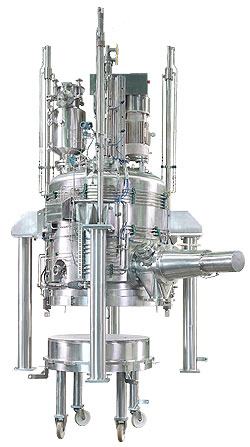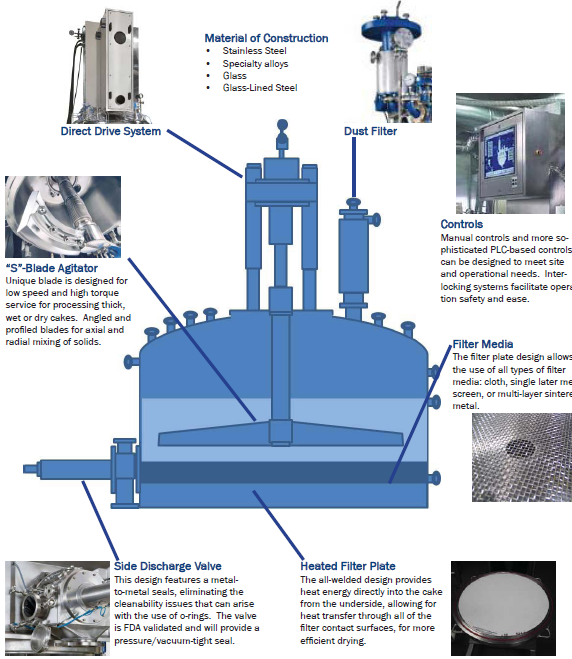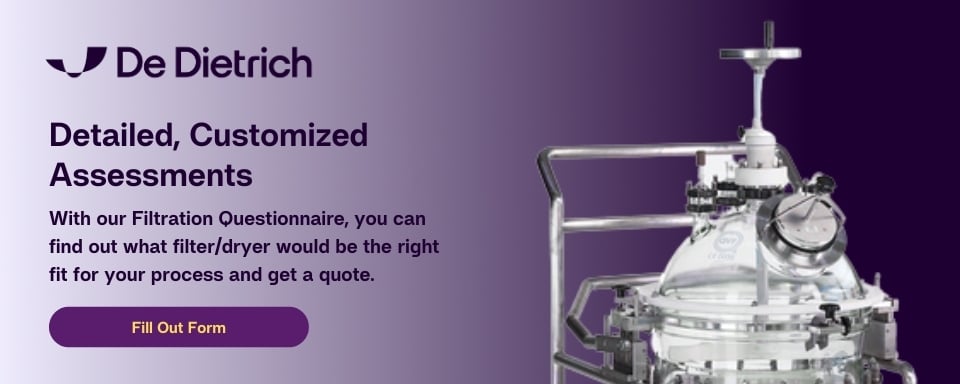Introduction to Agitated Nutsche Filter/Dryers
 The agitated nutsche filter/dryer is a multipurpose piece of equipment that you can find in a wide range of industrial processes. Often found just downstream of a reactor or crystallizer, it has the important job of separating and isolating solids from a solvent. It has certainly come a long way since its beginning, when the nutsche filter design consisted of an open vessel that simply used suction to achieve separation. Modernization by Rosenmund started in the 1960’s, when the vessel design was enclosed for containment, enabling the introduction of pressure and agitation. The closed system further allowed for process control on parameters like temperature, pressure, pH, and agitation. In addition to expanding the unit’s operations, containment helped to protect operators from product environment as well as isolate the product from the atmosphere.
The agitated nutsche filter/dryer is a multipurpose piece of equipment that you can find in a wide range of industrial processes. Often found just downstream of a reactor or crystallizer, it has the important job of separating and isolating solids from a solvent. It has certainly come a long way since its beginning, when the nutsche filter design consisted of an open vessel that simply used suction to achieve separation. Modernization by Rosenmund started in the 1960’s, when the vessel design was enclosed for containment, enabling the introduction of pressure and agitation. The closed system further allowed for process control on parameters like temperature, pressure, pH, and agitation. In addition to expanding the unit’s operations, containment helped to protect operators from product environment as well as isolate the product from the atmosphere.
While the agitated nutsche filter/dryer maintains its original process functionality, the advancements made in recent decades have made it a critical component in contained batch processes for carrying out final and intermediate product isolation. Specialty batch-oriented applications like pharmaceutical and fine chemical production, dye, paint, and wastewater treatment commonly utilize agitated nutsche filter/dryers. This is because nutsche filter/dryers are suited to handle even the most hazardous products (flammable, toxic, corrosive, etc.).
Nutsche filter/dryers are very flexible from a process standpoint; while they are typically used to reclaim solid products, there are rare instances when the solution is the desired end product (e.g. catalyst recovery, extraction, etc…). The modern day nutsche filter can perform a multitude of tasks including filling/charging, filtering, displacement washing, reslurry washing, smoothing, drying/cooling, and discharging. (For more details about each phase read our post about Understanding the Nutsche Filtration and Drying Process.) Combining the various filtration and drying steps in the same unit is a desirable function, especially for processing active pharmaceutical ingredients (API) and hazardous chemical compounds such as pesticides.
Nutsche Filter Configuration
The nutsche filter/dryer is comprised of four key components:
- Vessel – The body of the filter/dryer is available in a one- or two-piece design in addition to multiple base options. Vessels can be jacketed for temperature sensitive applications in order to provide effective heat transfer to the product. Insulation and sheathing, main body flanges, and pusher ports are also optional features.
- Drive assembly – The agitator system consists of an S-blade agitator, twin or quad column support structure, bellows, gear box, shaft coupling, and double dry mechanical seal.
- Discharge valve – The fail-safe design of a side discharge valve features a metal-to-metal seal, pressure capabilities, hinge, monorail, and hydraulic actuation to reliably handle the automatic discharge of dry product, solvent, slurry, or wet product.
- Dust filter – Flange-mounted to the top of the vessel, the dust filter can accommodate various types of filter media and comes fully jacketed with insulation and sheathing in a pressure rated housing to safely and effectively eliminate dust blowback. It also includes a nitrogen accumulation tank for contained element removal.

Construction
Due to the nature of the processes that are typically performed (i.e. highly toxic, require containment), nutsche filter/dryers are usually constructed of either stainless steel, specialty alloys or glass-lined steel. They are also available in borosilicate glass 3.3 for applications where chemical inertness and visibility are important. Additional modifications can be made to the design to accommodate cGMP, CIP, aseptic, and sterile requirements. Since the nutsche filter/dryer is a batch system, it must be sized according to your upstream equipment capacity.
While there are some smaller-scale manually operated nutsche filter/dryers available (see more information on our Roman Filter, for example), most units are automated and use a combination of electric, pneumatic, and hydraulic systems for actuation. The operational sequence of full production-sized machines involves a complex series of discharge valve and agitator system manipulations, so most units are semi or fully automated.
The three main types of filter media that are used to cover the filter plate are woven metallic mesh screen, synthetic filter cloth, and sintered metallic plate. The material is determined by the characteristics of the solids, the liquid, and the vessel material of construction. If unsure, pilot testing is the best way to determine medium selection.
Nutsche Filter/Dryer Applications
Not every separation process requires the level of technology provided by a nutsche. Nutsche filter/dryers are best selected for applications with the following process requirements:
- Minimum floor space
- Risk of environmental hazard from toxic or flammable products
- Precise temperature control
- Reslurry washing
- Absolute separation between the mother liquor and wash solutions
- Delicate cakes (i.e. tend to crack easily)
As with all specialized equipment, nutsche filter/dryers are not intended to be a solution for all separation processes. They should be selected with care. In instances where cakes are slow to form or are sticky, if the process is continuous, or if the product deteriorates during a long period of downtime the technology may not be an appropriate solution.
Multipurpose Agitator
The S-blade agitator is a unique feature of the nutsche filter/dryer and helps not only with mixing but reslurry, cake formation, drying, and product discharge. When the agitator is run in reversed rotation (counterclockwise), it exerts controlled pressure on the surface of the cake, effectively sealing cracks and maintaining a uniform cake so that air or gas will not bypass the filtration bed. To further reduce cake moisture, the heated agitator can be slowly rotated and lowered to scrape and de-lump the cake while providing an additional source of heat to enhance drying. Whether using conductive vacuum or convective pressure drying, you can accomplish drying with less than < 0.1% final product moisture possible. This video demonstrates how the agitator facilitates drying:
The agitator also serves as the main vehicle for product discharge. When rotated clockwise, it pushes the dry cake towards the vessel wall during each rotation, thus expelling product intermittently out through the side discharge valve.
Nutsche filter/dryers can effectively perform the separation of solid matter from a liquid under pressure or vacuum, in a closed system. The ability to isolate the product not only reduces product handling but also minimizes operator exposure and serves as environmental protection against solvent vaporization. Additionally, if you are in the pharmaceutical field or other industry where containment is critical, the high level of containment maintained can comply with GMP and other health and safety requirements (< 1µg/m³ on 8 Hr TWA). De Dietrich offers nutsche filter/dryers from laboratory to production scale with different materials of constructions and features to meet the requirements of your product. For a complimentary assessment, fill out our Filtration Questionnaire and give us the details of your process or contact us at 908-317-2585 so we can help identify a solution for your filtration and drying needs.

